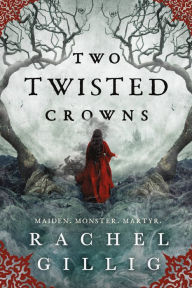Hold Your Cards Close — One Dark Window, Two Twisted Crowns and the Deck of Providence Cards: An Exclusive Guest Post from Rachel Gillig, Author of Two Twisted Crowns
Two Twisted Crowns
Two Twisted Crowns
In Stock Online
Paperback $18.99
The spellbinding sequel to one of our former monthly picks, One Dark Window, Two Twisted Crowns takes us on a journey to save a kingdom in peril. Elspeth and Ravyn’s quest sends them through a dangerous forest with the monster reluctantly sharing Elspeth’s head as their guide. Don’t miss this atmospheric end to the Shepherd King duology. Keep reading for a guest post from Rachel Gillig about the magic system she created in this duology.
The spellbinding sequel to one of our former monthly picks, One Dark Window, Two Twisted Crowns takes us on a journey to save a kingdom in peril. Elspeth and Ravyn’s quest sends them through a dangerous forest with the monster reluctantly sharing Elspeth’s head as their guide. Don’t miss this atmospheric end to the Shepherd King duology. Keep reading for a guest post from Rachel Gillig about the magic system she created in this duology.
Welcome to the kingdom of Blunder, where nothing comes for free, especially magic. Here there are twelve different kinds of magical cards known as Providence Cards, each lending its own unique power to whomever taps it. They’re worth their weight in gold — but the price of using them too long may prove far greater.
But how did Providence Cards begin? The Shepherd King bartered hair and bones and pieces of himself to forge them, but luckily creating them myself was less taxing. That being said, it’s almost comical how difficult it is for me to articulate how the Cards came to exist (my mind is a murky, resonant cave). Yes, there are distinct similarities between Providence Cards and tarot, but the inception of the Cards did not begin as an ode to tarot. It began with a simple love for stories that explore magical abilities — invisibility, mind control, foresight, etc. I’m fascinated with unpredictable, chaotic magic that effects everyone differently. But there is also a loud part of me that craves rules. So I created both kinds of magic for my duology. The unpredictable infection that grants magical abilities through a fever, and its foil — a finite, tangible, rule-based system. The Deck of Providence Cards.
There were edits, mind you. There always are. Nothing fledgling is faultless. I had a document of all twelve Providence Cards where I fashioned out what each Card looked like, what its distinct magic achieved, and what would happen if someone used it too long. When I was satisfied, I let the Cards loose on the kingdom of Blunder. And what a delight, because what I discovered while writing One Dark Window, then more profoundly in Two Twisted Crowns, is that a rule-based magic system set fascinating perimeters to explore the people within it. Characters like Elspeth with the Nightmare Card, Ravyn with the Mirror, Elm with the Scythe, Ione with the Maiden — what deficiencies, what fears or insecurities, do these particular Cards compensate for? What does it say about the people of Blunder if they harmfully break a Card’s rules, even for a good reason? Do they even know who they are without the Cards?
When I picture One Dark Window, I imagine all the characters holding Providence Cards in front of their faces like a mask. When I picture Two Twisted Crowns, the Cards are ripped away, leaving behind claw marks. This sequel is far more vulnerable than its predecessor, and while the characters are desperate to hold their Cards close, there is a strange sort of beauty it taking the rules of a carefully crafted magic system and bending them until they break.

